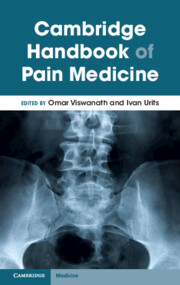Book contents
- Cambridge Handbook of Pain Medicine
- Cambridge Handbook of Pain Medicine
- Copyright page
- Contents
- Contributors
- Pain Handbook Introduction
- Part I Introduction to Pain: Pain Signaling Pathways
- Part II Common Categories of Pharmacologic Medications to Treat Chronic Pain
- Part III Chronic Pain Conditions Head and Neck
- Part IV Spine
- Part V Extremities
- Part VI Misc
- Chapter 26 Post-herpetic Neuralgia (PHN)
- Chapter 27 Complex Regional Pain Syndrome (CRPS)
- Chapter 28 Sickle Cell Disease
- Chapter 29 Breast Pain
- Chapter 30 Post-thoracotomy Pain
- Chapter 31 Multiple Sclerosis Pain
- Chapter 32 Cerebral Palsy
- Chapter 33 Myofascial Pain Syndrome
- Chapter 34 Post-stroke Pain
- Chapter 35 Chronic Abdominal Pain
- Chapter 36 Chronic Pelvic Pain
- Chapter 37 Postsurgical Nerve Entrapment
- Chapter 38 Cancer Pain
- Part VII Adjunctive Therapy
- Index
- References
Chapter 37 - Postsurgical Nerve Entrapment
from Part VI - Misc
Published online by Cambridge University Press: 01 December 2023
- Cambridge Handbook of Pain Medicine
- Cambridge Handbook of Pain Medicine
- Copyright page
- Contents
- Contributors
- Pain Handbook Introduction
- Part I Introduction to Pain: Pain Signaling Pathways
- Part II Common Categories of Pharmacologic Medications to Treat Chronic Pain
- Part III Chronic Pain Conditions Head and Neck
- Part IV Spine
- Part V Extremities
- Part VI Misc
- Chapter 26 Post-herpetic Neuralgia (PHN)
- Chapter 27 Complex Regional Pain Syndrome (CRPS)
- Chapter 28 Sickle Cell Disease
- Chapter 29 Breast Pain
- Chapter 30 Post-thoracotomy Pain
- Chapter 31 Multiple Sclerosis Pain
- Chapter 32 Cerebral Palsy
- Chapter 33 Myofascial Pain Syndrome
- Chapter 34 Post-stroke Pain
- Chapter 35 Chronic Abdominal Pain
- Chapter 36 Chronic Pelvic Pain
- Chapter 37 Postsurgical Nerve Entrapment
- Chapter 38 Cancer Pain
- Part VII Adjunctive Therapy
- Index
- References
Summary
There are simple and accurate methods to identify nerve entrapment; however, it is still underdiagnosed and undertreated. Giving postsurgical nerve entrapment more attention will decrease morbidity, improve outcomes, and decrease healthcare worker costs. Physicians and other medical providers should be highly suspicious of postsurgical nerve entrapment, particularly when patients present with over one to two months of unresolved pain. Nonoperative management includes pharmacotherapy, psychical therapy, and injections. Injections and blocks should be performed under ultrasound guidance. Neuroablative therapy and cryoanalgesic ablation are still being explored and need to be further studied. Refractory neuropathic pain unresolved with pharmacotherapy and nonoperative procedures should undergo neurectomy.
- Type
- Chapter
- Information
- Cambridge Handbook of Pain Medicine , pp. 303 - 307Publisher: Cambridge University PressPrint publication year: 2023

